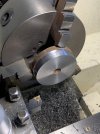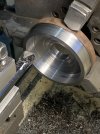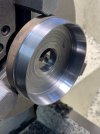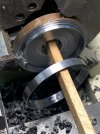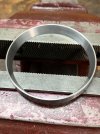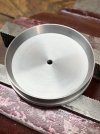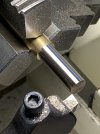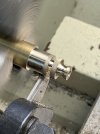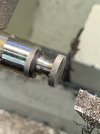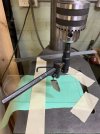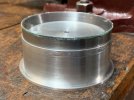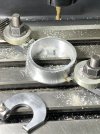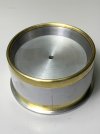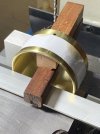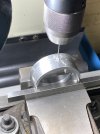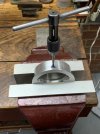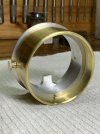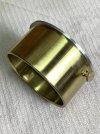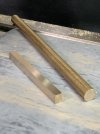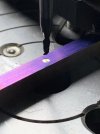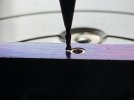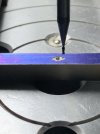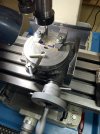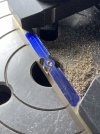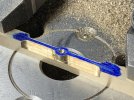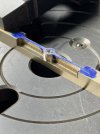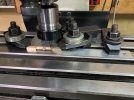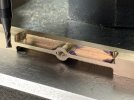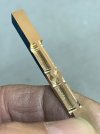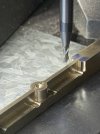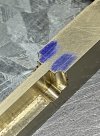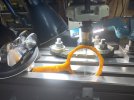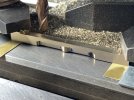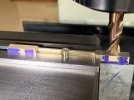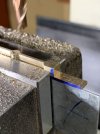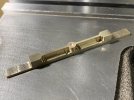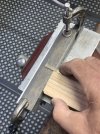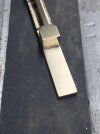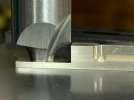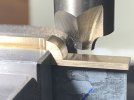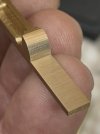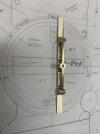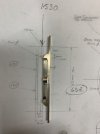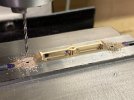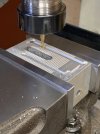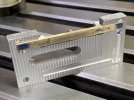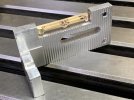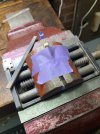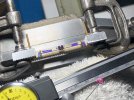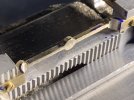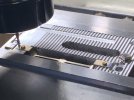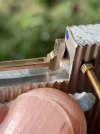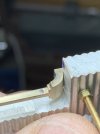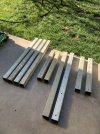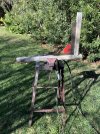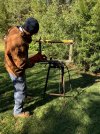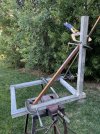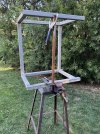David Waite
Western Thunderer
All the holes are done and the Aluminium Back trimmed to its finished size.
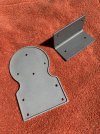
The two outer most holes in the circle section are for the wires to enter the instrument, the four small partly recessed milled holes are representing
the ends of screws finishing in tapped holes entering from the other side, these screws two per side held a screw terminal
to the back that the line wires attached to and the enamel wires from the coil connected to, the top hole and lower hole were originally
there to hold the instruments mechanism to the back but I am using these holes to hold the second section of Aluminium to the back
and as for the little hole in the middle I have no idea it is there on the prototype so I drilled it, maybe a oil hole for the rear bearing?.
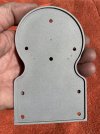
Next is the second half of the back to be made this piece of Aluminium is 86mm x 86mm and is 25mm thick
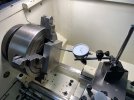
The block was turned down to a diameter slightly larger than the outer circle diameter of the back piece already made.
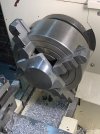
The block was spun around to start the machining the only reason I am still using the 8"four jaw chuck is
my three jaw chuck was at its limit and this was a safer way to go.
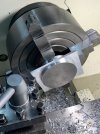
Most of the main turning is done the section under the jaws still needs to be thinned down.
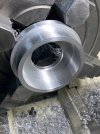
A trial fit of the Brass Casing when the piece under the jaws is turned a little more the Brass Casing will slide
further along.
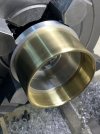
On to the mill for the next stage shown here are sections of the inside of the back flange being cut away this is to allow clearance for the mechanism leaving behind two protruding block pieces these will have tapped holes in them for the two screws to attach this Aluminium piece to the Aluminium Back.
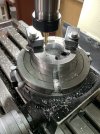
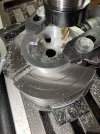
Back to the lathe and this time clamped in the three jaw chuck to turn the flange a little more there is still some turning to
be done to the piece that is left but due to its shape being easily damaged I will leave it to last.

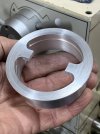
The Aluminium piece will need to be machined down a little once I decide on what thickness of glass I will be using.
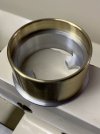
A face plate was turned up with a slide fit into the brass casing.
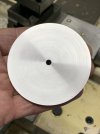
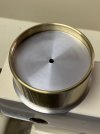
There is no plan for this part of the build I'm just working it out as I go along, so far so good.
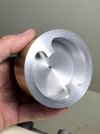

The two outer most holes in the circle section are for the wires to enter the instrument, the four small partly recessed milled holes are representing
the ends of screws finishing in tapped holes entering from the other side, these screws two per side held a screw terminal
to the back that the line wires attached to and the enamel wires from the coil connected to, the top hole and lower hole were originally
there to hold the instruments mechanism to the back but I am using these holes to hold the second section of Aluminium to the back
and as for the little hole in the middle I have no idea it is there on the prototype so I drilled it, maybe a oil hole for the rear bearing?.

Next is the second half of the back to be made this piece of Aluminium is 86mm x 86mm and is 25mm thick

The block was turned down to a diameter slightly larger than the outer circle diameter of the back piece already made.

The block was spun around to start the machining the only reason I am still using the 8"four jaw chuck is
my three jaw chuck was at its limit and this was a safer way to go.

Most of the main turning is done the section under the jaws still needs to be thinned down.

A trial fit of the Brass Casing when the piece under the jaws is turned a little more the Brass Casing will slide
further along.

On to the mill for the next stage shown here are sections of the inside of the back flange being cut away this is to allow clearance for the mechanism leaving behind two protruding block pieces these will have tapped holes in them for the two screws to attach this Aluminium piece to the Aluminium Back.


Back to the lathe and this time clamped in the three jaw chuck to turn the flange a little more there is still some turning to
be done to the piece that is left but due to its shape being easily damaged I will leave it to last.


The Aluminium piece will need to be machined down a little once I decide on what thickness of glass I will be using.

A face plate was turned up with a slide fit into the brass casing.


There is no plan for this part of the build I'm just working it out as I go along, so far so good.


